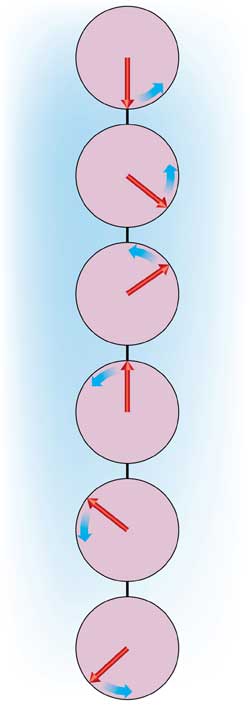Predicting a chain of order

Figure 1: A one-dimensional chain of spins (red arrows), showing a chiral ordering (or spiral), which rotate (blue arrows) in response to incoming light radiation. Copyright : 2011 The American Physical Society
The properties of a material are greatly affected by the electrical and magnetic structure of its constituent ions and electrons. In a ferromagnet, for example, neighboring electron spins point in the same direction, producing a strong external magnetic field. In an antiferromagnet, however, neighboring spins point in opposite directions, negating its magnetism. This behavior can be exploited in devices ranging from switches to memory and computers.
Multiferroic materials exhibit an even richer physics—and an expanded set of applications—because their magnetic and electrical orderings are linked. However, the magnetic and electrical structuring of multiferroics is not yet completely understood. Now, Shunsuke Furukawa, Masahiro Sato and Shigeki Onoda of the RIKEN Advanced Science Institute, Wako, have successfully calculated how magnetic ordering arises in one-dimensional multiferroic materials—the simplest example of these materials[1].
This simplicity means that one-dimensional multiferroic materials are useful models for understanding multidimensional, or ‘bulk’, multiferroic materials. Their one-dimensional chain of spins can not only assume a variety of ferromagnetic and anti-ferromagnetic alignments, but they can also arrange into more complicated patterns, including spirals defined over long portions of the chain—referred to as ‘long-range chiral order’ (Fig. 1). Understanding these exotic patterns may lead to new foundational science, as well as new applications. In addition, a one-dimensional chain can also exhibit the electrical control of magnetic structure and the response to light that is characteristic of more complex multiferroics.
Onoda and colleagues focused on describing the magnetic structure in a one-dimensional chain in terms of how strongly neighboring spins were coupled to each other. They began by using a computational technique that uniquely allows for the accurate treatment of an infinitely large collection of spins to construct a phase diagram describing how spin ordering changed as the type of spin-to-spin coupling in the material changed. Most notably, the diagram indicated that ferromagnetic coupling between nearest neighbors was much more likely to cause a long-range chiral order than anti-ferromagnetic coupling.
This observation successfully explained the experimentally observed spin ordering of several one-dimensional multiferroic cuprates. In particular, the research team was able to correctly predict that the bulk multiferroic material LiCu2O2, whose unique physics has drawn the attention of physicists for over a decade, exhibits chiral order and has a unique response to light. “These results confirm that one-dimensional multiferroics are an ideal laboratory for studying spin dynamics”, says Onoda, and he feels that the calculations will promote studies on new one-dimensional multiferroics and other novel states of matter.
The corresponding author for this highlight is based at the Condensed Matter Theory Laboratory, RIKEN Advance Science Institute
Journal information
[1] Furukawa, S., Sato, M. & Onoda, S. Chiral order and electromagnetic dynamics in one-dimensional multiferroic cuprates. Physical Review Letters 105, 257205 (2010).
Media Contact
All latest news from the category: Physics and Astronomy
This area deals with the fundamental laws and building blocks of nature and how they interact, the properties and the behavior of matter, and research into space and time and their structures.
innovations-report provides in-depth reports and articles on subjects such as astrophysics, laser technologies, nuclear, quantum, particle and solid-state physics, nanotechnologies, planetary research and findings (Mars, Venus) and developments related to the Hubble Telescope.
Newest articles

Superradiant atoms could push the boundaries of how precisely time can be measured
Superradiant atoms can help us measure time more precisely than ever. In a new study, researchers from the University of Copenhagen present a new method for measuring the time interval,…

Ion thermoelectric conversion devices for near room temperature
The electrode sheet of the thermoelectric device consists of ionic hydrogel, which is sandwiched between the electrodes to form, and the Prussian blue on the electrode undergoes a redox reaction…

Zap Energy achieves 37-million-degree temperatures in a compact device
New publication reports record electron temperatures for a small-scale, sheared-flow-stabilized Z-pinch fusion device. In the nine decades since humans first produced fusion reactions, only a few fusion technologies have demonstrated…





















